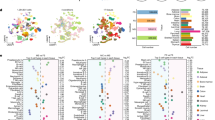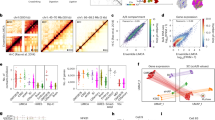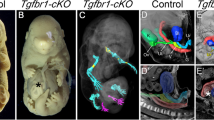Abstract
The mammalian vomeronasal organ (VNO), a part of the olfactory system, detects pheromones—chemical signals that modulate social and reproductive behaviours1,2. But the molecular receptors in the VNO that detect these chemosensory stimuli remain undefined. Candidate pheromone receptors are encoded by two distinct and complex superfamilies of genes, V1r and V2r (refs 3 and 4), which code for receptors with seven transmembrane domains. These genes are selectively expressed in sensory neurons of the VNO. However, there is at present no functional evidence for a role of these genes in pheromone responses. Here, using chromosome engineering technology5, we delete in the germ line of mice a ∼600-kilobase genomic region that contains a cluster of 16 intact V1r genes6. These genes comprise two of the 12 described V1r gene families7, and represent ∼12% of the V1r repertoire. The mutant mice display deficits in a subset of VNO-dependent behaviours: the expression of male sexual behaviour and maternal aggression is substantially altered. Electrophysiologically, the epithelium of the VNO of such mice does not respond detectably to specific pheromonal ligands. The behavioural impairment and chemosensory deficit support a role of V1r receptors as pheromone receptors.
This is a preview of subscription content, access via your institution
Access options
Subscribe to this journal
Receive 51 print issues and online access
$199.00 per year
only $3.90 per issue
Buy this article
- Purchase on Springer Link
- Instant access to full article PDF
Prices may be subject to local taxes which are calculated during checkout




Similar content being viewed by others
References
Halpern, M. The organisation and function of the vomeronasal system. Annu. Rev. Neurosci. 10, 325–362 (1987)
Keverne, E. B. The vomeronasal organ. Science 286, 716–720 (1999)
Dulac, C. & Axel, R. A novel family of genes encoding putative pheromone receptors in mammals. Cell 83, 195–206 (1995)
Tirindelli, R., Mucignat-Caretta, C. & Ryba, N. J. Molecular aspects of pheromonal communication via the vomeronasal organ of mammals. Trends Neurosci. 21, 482–486 (1998)
Ramirez-Solis, R., Liu, P. & Bradley, A. Chromosome engineering in mice. Nature 378, 720–724 (1995)
Del Punta, K., Rothman, A., Rodriguez, I. & Mombaerts, P. Sequence diversity and genomic organization of vomeronasal receptor genes in the mouse. Genome Res. 10, 1958–1967 (2000)
Rodriguez, I., Del Punta, K., Rothman, A., Ishii, T. & Mombaerts, P. Multiple new and isolated families within the mouse superfamily of V1r vomeronasal receptors. Nature Neurosci. 5, 134–139 (2002)
Holy, T. E., Dulac, C. & Meister, M. Responses of vomeronasal neurons to natural stimuli. Science 289, 1569–1572 (2000)
Leinders-Zufall, T. et al. Ultrasensitive pheromone detection by mammalian vomeronasal neurons. Nature 405, 792–796 (2000)
Sam, M. et al. Odorants may arouse instinctive behaviours. Nature 412, 142 (2001)
Wysocki, C. J. & Lepri, J. J. Consequences of removing the vomeronasal organ. J. Steroid Biochem. Mol. Biol. 4, 661–669 (1991)
Lane, R. P., Cutforth, T., Axel, R., Hood, L. & Trask, B. J. Sequence analysis of mouse vomeronasal receptor gene clusters reveals common promoter motifs and a history of recent expansion. Proc. Natl Acad. Sci. USA 99, 291–296 (2002)
Bean, N. J. & Wysocki, C. J. Vomeronasal organ removal and female mouse aggression: the role of experience. Physiol. Behav. 45, 875–882 (1989)
Bean, N. J. Olfactory and vomeronasal mediation of ultrasonic vocalizations in male mice. Physiol. Behav. 28, 31–37 (1982)
Wysocki, C. J., Nyby, J., Whitney, G., Beauchamp, G. K. & Katz, Y. The vomeronasal organ: primary role in mouse chemosensory gender recognition. Physiol. Behav. 29, 315–327 (1982)
Bean, N. J. Modulation of agonistic behavior by the dual olfactory system in male mice. Physiol. Behav. 29, 433–437 (1982)
Clancy, A. N., Coquelin, A., Macrides, F., Gorski, R. A. & Noble, E. P. Sexual behavior and aggression in male mice: involvement of the vomeronasal system. J. Neurosci. 4, 2222–2229 (1984)
Ogawa, S. et al. Abolition of male sexual behaviors in mice lacking estrogen receptors α and β (αβERKO). Proc. Natl Acad. Sci. USA 97, 14737–14741 (2000)
Amoore, J. E. & Steinle, S. in Chemical Senses Vol. 3, Genetics of Perception and Communication (eds Wysocki, C. J. & Klare, M. R.) 331–351 (Marcel Dekker, New York, 1991)
Takigami, S. et al. The expressed localisation of rat putative pheromone receptors. Neurosci. Lett. 272, 115–118 (1999)
Belluscio, L., Koentges, G., Axel, R. & Dulac, C. A map of pheromone receptor activation in the mammalian brain. Cell 97, 209–220 (1999)
Rodriguez, I., Feinstein, P. & Mombaerts, P. Variable patterns of axonal projections of sensory neurons in the mouse vomeronasal system. Cell 97, 199–208 (1999)
Mombaerts, P. Seven-transmembrane proteins as odorant and chemosensory receptors. Science 286, 707–711 (1999)
Firestein, S. How the olfactory system makes sense of scents. Nature 413, 211–218 (2001)
Slotnick, B. & Bodyak, N. Odor discrimination and odor quality perception in rats with disruption of connections between the olfactory epithelium and olfactory bulbs. J. Neurosci. 22, 4205–4216 (2002)
Hildebrand, J. G. Analysis of chemical signals by nervous systems. Proc. Natl Acad. Sci. USA 92, 67–74 (1995)
Sorensen, P. W., Christensen, T. A. & Stacey, N. E. Discrimination of pheromonal cues in fish: emerging parallels with insects. Curr. Opin. Neurobiol. 8, 458–467 (1998)
Leypold, B. G. et al. Altered sexual and social behaviors in trp2 mutant mice. Proc. Natl Acad. Sci. USA 99, 6376–6381 (2002)
Stowers, L., Holy, T. E., Meister, M., Dulac, C. & Koentges, G. Loss of sex discrimination and male-male aggression in mice deficient for TRP2. Science 295, 1493–1500 (2002)
Matzuk, M. M., Finegold, M. J., Su, J. G., Hsueh, A. J. & Bradley, A. Alpha-inhibin is a tumour-suppressor gene with gonadal specificity in mice. Nature 360, 313–319 (1992)
Acknowledgements
We thank R. Peraza and A. Walsh for producing chimaeric mice, D. Pfaff for fostering this collaboration, M. Novotny for providing 2,3-dehydro-exo-brevicomin and 6-hydroxy-6-methyl-3-heptanone, and T. Bozza, S. Firestein, C. Greer, K. Kelliher and D. Pfaff for critical reading of the manuscript. Postdoctoral fellowship support to I.R. was from the Swiss National Foundation for Research. Grant support to T.L-Z. and F.Z. was from NIH/NIDCD, and to P.M. from the March of Dimes Birth Defects Foundation.
Author information
Authors and Affiliations
Corresponding author
Ethics declarations
Competing interests
The authors declare that they have no competing financial interests.
Rights and permissions
About this article
Cite this article
Del Punta, K., Leinders-Zufall, T., Rodriguez, I. et al. Deficient pheromone responses in mice lacking a cluster of vomeronasal receptor genes. Nature 419, 70–74 (2002). https://doi.org/10.1038/nature00955
Received:
Accepted:
Issue Date:
DOI: https://doi.org/10.1038/nature00955
This article is cited by
-
CD20/MS4A1 is a mammalian olfactory receptor expressed in a subset of olfactory sensory neurons that mediates innate avoidance of predators
Nature Communications (2024)
-
Coding of pheromones by vomeronasal receptors
Cell and Tissue Research (2021)
-
Distinct evolutionary trajectories of V1R clades across mouse species
BMC Evolutionary Biology (2020)
-
Convergent reduction of V1R genes in subterranean rodents
BMC Evolutionary Biology (2019)
-
An incoherent feed-forward loop switches the Arabidopsis clock rapidly between two hysteretic states
Scientific Reports (2018)
Comments
By submitting a comment you agree to abide by our Terms and Community Guidelines. If you find something abusive or that does not comply with our terms or guidelines please flag it as inappropriate.



